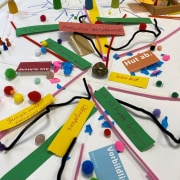How “learning leadership” succeeds
22.02.2020
Learning leadership – is that possible? Do we need it? Does it still fit in with the times? Does it make sense?
Let’s assume so, how could it look like then?
Surely the times of standardized management curricula lasting several weeks are over. Regardless of whether they are conducted in St. Gallen, at the Hernstein Institute or in in-house qualification programs. The requirements and expectations of customers have changed. Learning is different today and so is networking.
The fact that it works differently and is successful from the customer’s “executive” perspective is shown by the feedback of a pilot group of a customer’s holistically designed leadership and management development program. This group recently completed their two-year Learning Journey with a graduation. And what the participants reported in the retrospective suggests that they obviously did a lot right.
An impressive retrospective
The participants of the pilot group were simply fantastic in their ability to create a retrospective of their learning journey as individuals and as a group.
They expressed the digital competence they had developed in the meantime by making a film. Not only did the film highlight the various stages of the learner and Learning Journey, but the participants’ employees and superiors were also asked to show up in front of the camera to present their view of the impact of the qualification on the participants and their own organisation. By the way, no script had been written. Rather, this work was created in a creative collaboration in several iterations. An example of how the learning content on the topic of “new work” and “agile formats” came to life.
Afterwards, they arranged all participants in a “circle”, brought a (self-made) ball into play and let everyone have their say: The participants of the pilot group as well as the coaches and program managers and guests who had come to hear the learnings. Three questions provided the structure. The participants set the framework, initiated the process and then handed it over to self-organisation. This unit was prepared in peer groups and then collaboratively brought into the entire learning group without external facilitator. They already have the methodological and the social competence to turn those affected into participants.
Encouraging feedback
The feedback from the film and the following circle was inspiring and touching in many ways. In an unusual depth, people spoke openly about their own development. Many thanks were expressed for the many experiences and the lessons learned. There was talk of experienced and practiced appreciation. Acknowledgement of the progress made in building up competence in oneself and in others could be heard. The positive experience of cooperation and mutual support was especially emphasized. Examples of the sustainable effectiveness of qualification content in everyday life were mentioned. The weekly conference call set up in a peer group during the qualification trip was independently agreed upon as a regular call also beyond the qualification. This gave collegial consultation a space for sustainability. Learning in this new form received a certificate. This was combined with the request not to change anything, because learning makes sense and is effective in this way.
Learning leadership newly defined
How is this format designed to achieve such results and feedback from experienced managers?
On the one hand, it consistently follows the 70:20:10 approach, i.e. 70% of the qualification takes place at the workplace and by means of direct reference to the daily work routine. Here, virtual learning nuggets can also be consumed, which can be added to your own playlist according to individual needs. 20% of learning takes place in the community. Both in fixed peer groups and in the entire learning group. Routed via an exchange platform and supported by (video) calls. And 10% of the development takes place in face-to-face workshops. Particularly when the topics of person and behaviour are involved.
A transfer of the learning content into practice is consistently ensured with transfer tasks for the individual learner and in the virtual learner community. Often the learner’s work assignments also refer to their team or working environment. Here, primarily the long-term practical projects are to be seen. They demonstrate the business impact of the program and enable the development of competencies in (agile) project management.
Not to forget the highlight. Each participant is personally accompanied by a (virtual) coach. With this coach, individual concerns can be addressed. He/she also ensures that the participant always keeps the overview and direction in his/her largely self-organized learning journey.
Each participant has access to a comprehensive Wiki with in-depth content. Regular blogs help to ensure that the program always offers up-to-date content.
Learning leadership here means learning and iterating on the job. This starts with self-management, which is necessary for the program to come alive. After all, time for learning and development must be allowed by the participants themselves. This continues with the reflection on leadership in everyday work and the examination of the roles of “Manager & Leader” and their interaction. Leadership is also looked at from the future. This is where topics such as purpose, culture and new work come into play as well as new roles as change manager or enabler.
Then, there we are already talking about a Leader-Shift.
Redesigning leadership development.
That´s something we are good at.









